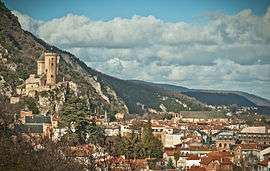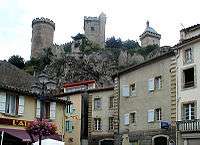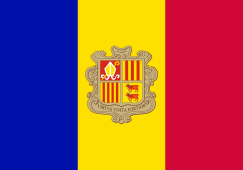Foix
| Foix | |||
|---|---|---|---|
| Prefecture and commune | |||
 View of Chateau de Foix in Lazema area | |||
| |||
 Foix Location within Occitanie region  Foix | |||
| Coordinates: 42°57′59″N 1°36′28″E / 42.9664°N 1.6078°ECoordinates: 42°57′59″N 1°36′28″E / 42.9664°N 1.6078°E | |||
| Country | France | ||
| Region | Occitanie | ||
| Department | Ariège | ||
| Arrondissement | Foix | ||
| Canton | Foix | ||
| Intercommunality | Pays Foix-Varilhes | ||
| Government | |||
| • Mayor (2014–2020) | Norbert Meler[1] (PS) | ||
| Area1 | 19.32 km2 (7.46 sq mi) | ||
| Population (2014)2 | 9,721 | ||
| • Density | 500/km2 (1,300/sq mi) | ||
| Demonym(s) | Fuxéen | ||
| Time zone | UTC+1 (CET) | ||
| • Summer (DST) | UTC+2 (CEST) | ||
| INSEE/Postal code | 09122 /09000 | ||
| Elevation |
358–933 m (1,175–3,061 ft) (avg. 400 m or 1,300 ft) | ||
| Website | www.mairie-foix.fr | ||
|
1 French Land Register data, which excludes lakes, ponds, glaciers > 1 km2 (0.386 sq mi or 247 acres) and river estuaries. 2 Population without double counting: residents of multiple communes (e.g., students and military personnel) only counted once. | |||
Foix (French pronunciation: [fwa]; Occitan: Fois [ˈfujs, ˈfujʃ]; Catalan: Foix [ˈfoʃ]) is a commune, the former capital of the County of Foix. Today it is the Préfecture of the Ariège department in southwestern France in the Occitanie region. It is the second least populous administrative centre of a department in all of France, the least-populous being Privas. Foix lies south of Toulouse, close to the border with Spain and Andorra. At the 2009 census, the city had a population of 9,861 people. It is only the second city of the department after Pamiers which is one of the two sub-prefectures. Foix is twinned with the English cathedral city of Ripon.
History

The Romans built a fort on the rocky hill where the Château de Foix castle now overlooks the town. The town of Foix probably owes its origin to an oratory founded by Charlemagne, which afterwards became the Abbey of Saint Volusianus in 849. The current area was preceded by the County of Foix.
The founding, in 849, of the Abbey Saint-Volusien allowed the development of urban living in the tenth century to the twelfth century. The city reached its peak in the fourteenth century.
The castle, whose foundations date back to the early tenth century, was a strong fortress that withstood the repeated attacks of Simon de Montfort IV between 1211 and 1217, during the Albigensian Crusade. In 1272, when the Count of Foix refused to recognize the sovereignty of the king of France, Philip the Bold personally took the leadership of an expedition against the city, subsequently the count surrendered. In 1290, at a meeting of the Béarn region and the county of Foix, the city was practically abandoned by the Counts. Gaston Phoebus was the last to have lived in the castle, and by the sixteenth century the castle had lost its military purpose. The castle was then used as a prison until 1864.
In 1536 began the first Reformation preaching in Foix, and in 1579 the church of Montgauzy was destroyed. The same fate awaited the abbey and its church in 1581. The following year, Foix was retaken by Catholics, and in 1589 the Count of Foix, Henry of Navarre, was crowned King of France and became Henry IV.
Education
Primary education
- Lucien Goron primary school
- Cadirac Primary School
- Cardie Primary School
- Courbet Primary School
- Bruilhols Primary School
Secondary education
- College Lakanal
- Gabriel Fauré General and Technological School
- Jean Durroux Vocational School
Higher Education
- Central University of the Ariège
Population
| Historical population | ||
|---|---|---|
| Year | Pop. | ±% |
| 1793 | 3,265 | — |
| 1800 | 3,509 | +7.5% |
| 1806 | 3,959 | +12.8% |
| 1821 | 4,552 | +15.0% |
| 1831 | 4,857 | +6.7% |
| 1836 | 4,699 | −3.3% |
| 1841 | 4,714 | +0.3% |
| 1846 | 5,086 | +7.9% |
| 1851 | 4,684 | −7.9% |
| 1856 | 5,257 | +12.2% |
| 1861 | 5,507 | +4.8% |
| 1866 | 6,746 | +22.5% |
| 1872 | 6,706 | −0.6% |
| 1876 | 6,362 | −5.1% |
| 1881 | 7,076 | +11.2% |
| 1886 | 7,369 | +4.1% |
| 1891 | 7,568 | +2.7% |
| 1896 | 6,722 | −11.2% |
| 1901 | 7,065 | +5.1% |
| 1906 | 6,750 | −4.5% |
| 1911 | 6,806 | +0.8% |
| 1921 | 6,165 | −9.4% |
| 1926 | 6,461 | +4.8% |
| 1931 | 6,279 | −2.8% |
| 1936 | 7,006 | +11.6% |
| 1946 | 7,798 | +11.3% |
| 1954 | 7,632 | −2.1% |
| 1962 | 8,156 | +6.9% |
| 1968 | 9,331 | +14.4% |
| 1975 | 9,599 | +2.9% |
| 1982 | 9,282 | −3.3% |
| 1990 | 9,964 | +7.3% |
| 1999 | 9,109 | −8.6% |
| 2008 | 9,712 | +6.6% |
| 2012 | 9,756 | +0.5% |
Heraldry
The coat of arms used by the commune has the blazon D'or à trois pals de gueules (gold with three red stripes). This is replicated on the flag, and in the arms of the département. It originates from the arms of the Counts of Foix, and, as such, dates back into medieval times. It bears a resemblance to the coat of arms of Catalonia, and also of Aragon, both featuring in the coat of arms of Andorra.
Philately
In 1955 the post office issued a postage stamp with a face value of 50 cents, consisting of the black, green, yellow and red representing the Arms of County of Foix which is referenced as YT 1044. It is part of the eighth century series of Provincial Coat of Arms.
In 1958, the post office issued a postage stamp with a face value of 15 f., consisting of Ultramarine, gray, brown and green representing the Château de Foix which is referenced YT 11759.
International relations
Foix is twinned with the following places:



Personalities
- Louis de Bassompierre, abbot of Saint-Volusien
- Frédéric Soulié (1800-1847), novelist, dramatist, critic and journalist.
- Charles de Freycinet (1828-1923), statesman and prime minister.
- Louis Pailhas (born 1926), director of the National School of Civil Aviation from 1967 to 1982
- Roger Bataille (1926-1962) painter
- Christian d'Orgeix (born 1927), surrealist painter
- Alexandre Rauzy, MP under the Third Republic, the Socialist Party activist and Democratic Socialist Party
- Eric Carrière, footballer
- Jean Clottes (1933-), world-renowned prehistorian
- George-Patrick Gleize, (1952-), writer
- Marc Bonneval (1953-2010), philosopher and translator
- Jean-Yves Ferri (1959-), author of comics
- Chloé Mortaud, Miss France
- Joseph Delteil (1909–1979), speleologist, died in Foix
Tour de France
Hosting History: • On historic Bastille Day, 14 July, the Town of Foix hosted the arrival of the 2017 TDF racing teams on Stage 13, St. Girons-Foix. • Hosted arrival Stage 14 in 2012 Tour de France, Limoux-Foix. • It was the finishing town of Stage 11 in the 2008 Tour de France, Lannemezan-Foix. • For the 2007 Tour de France, Foix hosted the start of Stage 15, Foix - Loudenvielle-Le Louron.
Sights
Botanical Garden
The botanical garden, Les Épines de Lespinet, has a collection of cacti and succulents, as well as citrus trees, banana plants, and Mediterranean vegetation.
Granary
The granary, dating from 1870, is in the style of Victor Baltard.
Castle
The castle stands on a rocky outcrop, to the west of the town. The majority of the present building dates from the twelfth century to the fourteenth century. In the North, the square tower, covered by a slated roof at the end of the nineteenth century, is certainly the oldest because it dates the eleventh and twelfth centuries. The middle tower, built in the thirteenth century, was completely renovated in the fourteenth century. It has beautiful architectural features such as sculpted heads and coats of arms keystones. The round tower on the other hand has Gothic architecture with large bays illuminating beautiful hexagonal vaulted halls.
Saint-Volusien Abbey
In 1104, the regular canons of St. Augustine took possession of an abbey housing the relics of St. Volusien. It was then that the construction of a large church with three naves, with a transept, was undertaken. In the fourteenth century, the Romanesque apse was replaced by a new polygonal chancel. The building was destroyed during the religious wars and the relics were burned. Reconstruction work was undertaken from 1609 and completed in 1670. Of the medieval church, there are mainly the portal and the base of the walls of the nave remaining. There is an organ of 40 stops, built by Fermis in 1869 and restored in 2007.
Old Town
This still retains its medieval character as reflected in the narrow streets (Rue des Marchands, the Rue des Chapeliers), and some half-timbered houses.
Chapel and area of Montgauzy
Of the primitive Romanesque church and the church of the thirteenth century, there is nothing left. The present church dates partly from 1628, and kept the Romanesque layout and a portal that imitates the style. The history of the chapel Montgauzy is hectic. Its foundation commemorates the victory of Charlemagne over the Moors in 778, and the chapel became a place of pilgrimage. In 1340, the Bishop of Pamiers, Arnaud Villemur, had to intervene against incivility of some of pilgrims which were becoming increasingly numerous (there were reports of noisy evenings). On 4 January 1562 the chapel was one of the many targets of the Reformation, and in 1579 the governor of the castle of Foix demolished it. It was rebuilt in 1628 and the pilgrimage recommenced. Following the revolution, having been rebuilt, it is sold in 1791. This private property, due to lack of maintenance, then falls apart. It is the turn of the department to make the purchase in 1840. An École Normale is installed in the area and the chapel in 1843 is made fit for worship. It closed again in 1883, and the furniture is scattered. After repairs in 1943, it was again reopened for worship.
The Alleys of Villote
The "Villote" (small town), in the Middle Ages, was a space outside the walls surrounding the city built in 1330. Executions took place sometimes at the alleys. In the thirteenth century, after the destruction of the city walls, tree planting and urban works with a fountain and orchestra setting, make it the choice for walking for the local Fuxéens. The site currently houses the festivities of the city, the market (every Friday) as well as many shops, eating places and public services.
Bibliography
See also
References
- ↑ "Ville de Foix" (in French). habitants.fr. Retrieved 27 March 2017.
External links
| Wikimedia Commons has media related to Foix. |
- Medieval History of Navarre
- Official website (in French)
- List of Counts of Foix
- Rulers of Languedoc (including Foix)
- Discover Foix on www.toulousevisit.com

